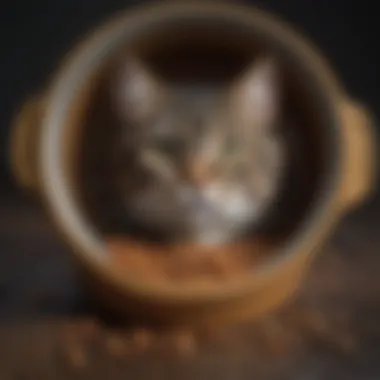In-Depth Guide to Purina Pro Plan Diabetic Cat Food


Intro
Understanding the dietary needs of pets, particularly diabetic cats, is crucial for their health and well-being. With the rising prevalence of diabetes in feline populations, the demand for appropriate nutrition increases. Purina Pro Plan Diabetic Wet Cat Food offers a specialized formula designed for these pets. This article will delve into the formulation, key benefits, and suitability of the food, providing insights that are necessary for effective management of feline diabetes.
Key Concepts and Terminology
Basic Definitions
To grasp the essence of Purina Pro Plan Diabetic Wet Cat Food, it is essential to clarify several concepts related to feline diabetes and nutrition. Feline diabetes mellitus is a metabolic disorder that leads to high glucose levels in the blood due to insufficient insulin production.
Diabetic Cat Food: This type of food is tailored to aid in controlling blood sugar levels and weight management. High protein and low carbohydrate content are common characteristics.
Historical Context
Historically, the understanding of feline diabetes has evolved over time, leading to better nutritional recommendations. In earlier years, most pet food did not consider the specific needs of diabetic animals. As research progressed, companies like Purina recognized the necessity for targeted nutrition. This paved the way for specialized formulations, specifically designed for diabetic cats, that cater to their unique conditions.
Recent Innovations and Trends
Technological Advancements
In recent years, advances in pet food technology have dramatically improved the formulation of diabetic cat foods. These innovations focus on creating highly digestible ingredients that improve nutrient absorption, thus promoting better metabolic health in diabetic cats. Ingredient sourcing now frequently incorporates functional ingredients such as prebiotics and probiotics to support gut health.
Sustainable Practices
Sustainability in pet food production is becoming more prevalent. Brands like Purina are increasingly focusing on ethical sourcing and environmentally friendly practices. This approach enables better ingredient quality while reducing the carbon footprint of production processes. Sustainable initiatives may involve using responsibly sourced proteins or developing eco-friendly packaging that minimizes waste.
Practical Applications and Techniques
Step-by-step Guides
To ensure optimal health for a diabetic cat, following correct feeding practices is vital. Here are some steps to consider:
- Consult a Veterinarian: Assess the cat's specific dietary needs based on its health condition.
- Transition to Diabetic Food: Gradually introduce Purina Pro Plan Diabetic Wet Cat Food to the cat’s diet over several days. This helps in avoiding digestive disturbances.
- Proper Portioning: Follow feeding guidelines based on the cat's weight and health needs. Monitoring weight regularly is beneficial.
- Frequent Monitoring: Keep track of glucose levels regularly to make adjustments as needed.
Case Studies
Several studies illustrate the effectiveness of using specialized diabetic cat foods. One notable case involved a cat that had been diagnosed with diabetes. After transitioning to Purina Pro Plan Diabetic Wet Cat Food, its blood sugar levels stabilized over a few months. Veterinary assessments confirmed improvements in overall health and energy levels. Autopsies demonstrated better weight management, which is essential in diabetic care.
"Proper nutrition is key in managing feline diabetes, and selecting the right food can make a significant difference in your pet's life."
This comprehensive examination of Purina Pro Plan Diabetic Wet Cat Food seeks to empower cat owners with essential knowledge. Understanding its formulation, historical context, and practical applications contributes to informed decision-making regarding feline diabetes management.
Foreword to Feline Diabetes
Diabetes in cats is a significant health concern that affects their overall well-being. Understanding this condition is important for pet owners, as it informs dietary choices and management strategies. This section will explore diabetes in felines, the implications it holds for their health, and the necessity of proper dietary formulation like Purina Pro Plan Diabetic Wet Cat Food.
Understanding Diabetes in Cats
Feline diabetes mellitus primarily manifests in two forms: Type 1 and Type 2. Type 1 diabetes is less common in cats and involves insufficient insulin production by the pancreas. Type 2 diabetes, however, is more prevalent and typically associated with insulin resistance. Affected cats may struggle to utilize glucose, leading to elevated blood sugar levels.
Symptoms of diabetes can include increased thirst, frequent urination, weight loss, and lethargy. Early detection is crucial. Regular vet check-ups will help in maintaining the health of a diabetic cat. The right diet, like those targeting low carbohydrate intake, plays a vital role in managing these symptoms and stabilizing blood sugar metrics.
Prevalence and Impact
Feline diabetes is becoming increasingly common, particularly among older cats. Studies indicate that the condition affects approximately one in 200 cats, with onset usually occurring around 7 to 10 years of age. The reasons behind the upward trend of this disease include obesity and sedentary lifestyles common in many indoor cats.
The impact of feline diabetes stretches beyond immediate health concerns. It poses long-term risks, including a higher likelihood of developing other conditions like urinary tract infections and pancreatitis. Moreover, managing diabetes can lead to increased veterinary costs. By providing targeted nutritional support, like that in Purina Pro Plan Diabetic Wet Cat Food, owners can help mitigate these risks. Proper dietary management is not just a treatment; it is an essential component in the life of a cat with diabetes, making understanding this topic paramount for all feline caretakers.
Nutritional Needs of Diabetic Cats


The diet of a diabetic cat is crucial for managing their health condition. Proper nutrition helps regulate blood sugar levels and enhances overall well-being. Diabetic cats require specific dietary considerations to maintain their energy levels, support metabolism, and prevent complications. This section will explore the importance of low carbohydrate diets and the role of protein in diabetic management. Each element is vital for ensuring that diabetic cats receive the nourishment they need while managing their condition effectively.
Importance of Low Carbohydrate Diets
Carbohydrates make up a significant part of many cat foods, but for diabetic cats, the story is different. Low carbohydrate diets have gained attention for their role in controlling glucose levels in felines. By reducing carbohydrates, owners can help stabilize their cat's blood sugar. This is particularly important because high carbohydrate intake can lead to spikes in glucose levels, which is detrimental for diabetic cats.
Consider the following reasons why low carbohydrate diets are essential for diabetic cats:
- Stable Blood Sugar Levels: Lowering the carbohydrate intake helps minimize fluctuations in blood sugar. This stability is key to effective diabetes management.
- Increased Fat Utilization: Cats are obligate carnivores, which means their bodies are wired to use protein and fat primarily for energy rather than carbohydrates. A low carb diet encourages the body to utilize fat stores effectively.
- Weight Management: Maintaining a healthy weight is critical for diabetic cats. Low carbohydrate diets can contribute to weight loss strategies, helping prevent obesity, which can exacerbate diabetes.
In summary, reducing carbohydrate content in the diet can lead to better glucose control and overall health for diabetic cats. It's an important consideration that every cat owner should take seriously.
Role of Protein in Diabetic Management
Protein plays a crucial role in the dietary management of diabetic cats. High protein diets provide essential amino acids necessary for muscle maintenance and overall health. In the context of diabetes, protein has several important benefits:
- Satiety: A high protein diet can promote a feeling of fullness, which helps prevent overeating. This is particularly helpful in managing weight control and preventing obesity in diabetic cats.
- Muscle Preservation: Maintaining muscle mass is essential for health, especially in older cats or those with diabetes. A diet rich in protein helps preserve lean body mass, which in turn supports metabolic health.
- Blood Sugar Regulation: Protein intake can promote better blood sugar levels by slowing the absorption of glucose. This means that cats can maintain more stable energy levels throughout the day, avoiding drastic fluctuations.
Purina Pro Plan Diabetic Wet Cat Food Overview
Understanding Purina Pro Plan Diabetic Wet Cat Food is vital for those managing feline diabetes. This product is not just another cat food; it serves a specific purpose tailored for diabetic cats. The formulation addresses the distinct dietary requirements that arise due to diabetes. The right nutrition contributes significantly to a diabetic cat's overall health, helping to manage blood glucose levels while also considering lean muscle maintenance.
In this section, we will cover its composition, key ingredients, and how these elements work together to promote the well-being of diabetic felines. Each aspect of the food contributes to its suitability for diabetic cats, highlighting its importance in managing this chronic condition.
Product Composition
The product composition of Purina Pro Plan Diabetic Wet Cat Food is meticulously designed. It typically contains high protein and low carbohydrate content, both crucial for managing cat diabetes. The protein helps support muscle maintenance, while lower carbohydrates aid in regulating blood sugar levels.
Key components generally include:
- Proteins sourced from real meat or fish.
- A controlled level of fat.
- Moisture content that supports hydration and palatability.
- Essential vitamins and minerals to support overall health.
This balanced composition means that each serving provides nourishment suitable for diabetic cats without the excessive calories that can lead to weight gain.
Key Ingredients Analysis
A closer look at the key ingredients provides insight into the benefits and effectiveness of Purina Pro Plan Diabetic Wet Cat Food. Each ingredient contributes to the product's overall functionality:
- Real Chicken or Turkey: These are primary protein sources, aiding in muscle maintenance and promoting satiety.
- Pork Liver: A highly palatable ingredient that also provides essential nutrients.
- Fish and Chicken Meal: These concentrated protein sources support high protein content while being low in carbohydrates.
- Taurine: An essential amino acid that supports heart health and vision.
- Vitamins and Minerals: These support immune function and overall health, making the food not just functional but also supportive of a cat's wellbeing.
When analyzing these ingredients, it becomes clear that they are not simply fillers but rather carefully selected to benefit the specific dietary needs of diabetic cats. Such choices help optimize metabolic function and weight management, all while ensuring that meals remain enjoyable.
Benefits of Purina Pro Plan for Diabetic Cats
Understanding the benefits of Purina Pro Plan Diabetic Wet Cat Food is essential for cat owners who seek effective dietary solutions for managing feline diabetes. This section examines how this specific formulation supports vital health aspects crucial for diabetic felines. Not only does it aid in maintaining a healthy weight, but it also plays a significant role in glucose control, both of which are necessary for diabetes management.
Weight Management
Weight management is a core component of diabetes control for cats. Diabetic felines are often prone to obesity, exacerbating their condition and making management more challenging. Purina Pro Plan offers a low-calorie formula that promotes a healthy weight by ensuring that cats consume fewer calories without sacrificing proper nutrition.
The high protein content helps maintain lean muscle mass, which is particularly important for cats on a weight loss journey. This dietary approach reduces the risks associated with losing weight too quickly, such as muscle wasting and related health issues.
- Key Features:
- Low fat content
- High protein to support muscle maintenance
- Balanced nutrients that promote satiety
These aspects combined enable cat owners to manage their pets' weight effectively, helping prevent further health complications or worsening of their diabetic state. With proper weight control, diabetic cats can enjoy a better quality of life.
Glucose Control
Glucose control is paramount in managing feline diabetes. This product is designed with a low carbohydrate profile, which is vital for stabilizing blood glucose levels. In fact, carbohydrates can lead to spikes in blood sugar, which are detrimental to diabetic cats.


Purina Pro Plan includes ingredients that are beneficial in moderating glucose absorption. The fiber content also aids digestion and regulates the rate of food breakdown, contributing to a steadier release of glucose into the bloodstream.
- Benefits of Fiber:
- Slow digestion regulates glucose levels
- Promotes a longer-lasting feeling of fullness
- Helps in weight management
By supporting stable blood sugar levels, Purina Pro Plan helps reduce the risks associated with diabetes, such as hyperglycemia and related complications. For cat owners, this translates into a more manageable daily routine and a healthier, happier feline.
In summary, effective weight management and glucose control provided by Purina Pro Plan are essential aspects of dietary management in diabetic cats.
Feeding Guidelines for Feline Diabetes
Feeding guidelines are crucial for managing feline diabetes effectively. The right approach to diet impacts blood glucose levels, weight management, and overall health in diabetic cats. Thus, implementing these guidelines should be a priority for pet owners. Correct management can reduce complications and improve the quality of life for affected felines.
Determining Portion Sizes
Portion sizes should be carefully calculated based on the cat's weight, age, and activity level. This ensures that the cat receives enough nutrition without excessive calories that can lead to weight gain. For diabetic cats, a common recommendation is to feed in small, frequent portions. This method helps maintain steady blood sugar levels, which is beneficial in managing diabetes.
- Calculate daily caloric needs: A veterinarian can assist in this task, establishing how many calories are appropriate based on the cat's specific situation.
- Use a kitchen scale: Measuring food accurately provides better control over portion sizes and helps avoid overfeeding.
- Monitor weight regularly: Adjust portions as necessary to ensure that the cat is neither losing nor gaining weight excessively.
Frequency of Feeding
The frequency of feeding contributes significantly to effective diabetic management. It is often beneficial to feed diabetic cats several small meals throughout the day. This approach helps to stabilize blood sugar levels and can lead to better overall health outcomes.
- Normal routine: Dividing the daily food intake into three or four meals is common.
- Consistency is key: Consistent feeding times aid in stabilizing blood glucose levels, ensuring that insulin administration aligns with the dietary intake.
- Avoid leaving food out: Unlike many cats who can nibble throughout the day, diabetic cats do best with scheduled meals to prevent food overconsumption.
Transitioning to New Food
When introducing Purina Pro Plan or any new food, the transition should be gradual. A sudden change can lead to gastrointestinal upset and may not help the cat's diabetes management effectively.
- Start slow: Begin by mixing a small amount of the new food with the current food.
- Monitor reactions: Observe the cat for any signs of discomfort or adverse reactions during the transition.
- Complete switch over time: Gradually increase the quantity of new food while decreasing the old food until the transition is complete, usually over a week or two.
"Proper diet is a cornerstone of managing diabetes in cats. It requires careful planning and execution."
In summary, feasible feeding guidelines include careful portion control, appropriate feeding frequency, and a gradual approach to dietary changes. These practices must align with veterinary advice tailored to each cat's specific needs. A well-managed diet enhances not only the diabetic cat’s health but also their wellbeing.
Veterinary Perspectives on Diabetic Nutrition
Understanding diabetic nutrition from a veterinary standpoint is crucial for managing the health of diabetic cats. Veterinarians possess extensive knowledge and experience in the nutritional needs of felines, especially those suffering from chronic conditions like diabetes. They can provide tailored dietary recommendations based on a cat's health status, age, weight, and any underlying conditions.
Consultation with a veterinarian ensures that the chosen diet supports the cat's overall health, beyond just managing blood glucose levels. A vet's guidance can help prevent complications arising from improper nutrition, ensuring that feline diabetes is managed effectively.
Importance of Consultation
Consulting with a veterinarian is not just beneficial; it is vital. Each diabetic cat is unique. Their dietary needs may differ based on several factors. This includes age, breed, activity level, and how well they respond to treatments. When owners collaborate with vets, they can design a nutrition plan that specifically addresses those needs.
Vets can also assist in identifying any allergies or sensitivities to certain ingredients. This can prevent adverse reactions to food, which might exacerbate the diabetic condition. Regular veterinary check-ups allow for monitoring changes in health status, which might require adjustments to the cat's diet.
"A tailored approach to diet can significantly impact the management of feline diabetes."
Monitoring and Adjustments
Monitoring a diabetic cat's health is essential in understanding how the diet affects their overall well-being. Regular veterinary check-ups allow for adjustments based on weight changes, glucose levels, and general health indicators.
It is important to track how a cat responds to their diet over time. For example, if a cat is losing weight too rapidly, it might necessitate a review of their caloric intake. Conversely, if glucose levels are not stabilizing, the vet may recommend changes to the formulation or composition of the food, including increased protein or reduced carbohydrates.
In addition to professional monitoring, pet owners should also observe their cats closely. Noticing changes in behavior, appetite, or energy levels can provide valuable insights into whether the current diet is effective. Keeping a feeding journal can help track what and how much the cat eats while correlating it with their health changes.
Adjustments to the diet based on these assessments promote better control over the diabetic condition. This collaborative effort between vets and cat owners fosters a more effective management plan for feline diabetes.
Potential Concerns with Purina Pro Plan


When considering diet options for diabetic cats, it is important to scrutinize each product carefully. Purina Pro Plan Diabetic Wet Cat Food offers specific benefits tailored to the nutritional requirements of these animals. However, there are potential concerns that merit attention. Addressing these aspects helps to ensure optimal health for diabetic felines. It is essential to evaluate ingredient quality and cost implications when making dietary choices.
Ingredient Sensitivities
Some cats may develop sensitivities or allergies to certain food ingredients. This can often lead to digestive issues or skin problems. For instance, Purina Pro Plan incorporates ingredients such as chicken, fish, and various vegetables. While these are generally well-tolerated, individual reactions can vary.
It is advisable for cat owners to monitor any changes in their pet's behavior or health after introducing new food. If adverse reactions are noted, consultation with a veterinarian is crucial to determine potential sensitivities. Consider keeping a food diary to track any symptoms and the respective meals.
Here are some common ingredients that may cause sensitivities:
- Chicken: While a common protein source, some cats may be allergic to poultry.
- Fish: Likewise, certain cats react adversely to fish-based ingredients.
- Grains: Although lower in carbohydrate content, some cats have grain allergies or intolerances.
Evaluating the Cost-Benefit Ratio
Purchasing quality cat food often comes at a price. A comprehensive analysis of the cost-benefit ratio concerning Purina Pro Plan is crucial. This evaluation includes comparing nutritional value with the price point. Higher-quality ingredients that fulfill a diabetic cat's unique requirements might justify a higher price.
When comparing Purina Pro Plan with other options, consider these factors:
- Ingredient Quality: Is the food made of high-quality sources? Are they free from fillers?
- Nutritional Adequacy: Does the formulation meet the specific dietary needs of a diabetic cat?
- Long-term Benefits: Investing in a suitable diet may reduce future health complications and veterinary costs.
In summary, while the price of Purina Pro Plan needs contemplation, the benefits it provides could outweigh the initial expense. Hence, engaging in an informed decision-making process is advised for cat owners, centered around ingredient quality and nutritional adequacy.
"Understanding the cost-benefit ratio is pivotal in making the best dietary choices for diabetic cats."
Overall, addressing concerns related to ingredient sensitivities and assessing the cost-benefit ratio are fundamental when considering Purina Pro Plan. Proper consultation with a veterinarian can aid in navigating these potential issues effectively.
Alternative Diets for Diabetic Cats
Dietary management is a fundamental component in the care of diabetic cats. While Purina Pro Plan Diabetic Wet Cat Food offers a specialized formulation, other alternatives may cater to the unique needs of these felines. Owners should consider both homemade diets and other commercial options to provide a balanced intake that helps regulate blood sugar levels effectively. Incorporating diverse dietary strategies can help meet individual cat requirements while keeping their health as the priority.
Homemade Diet Considerations
Creating a homemade diet for a diabetic cat requires careful planning and consideration. A well-balanced homemade meal can be tailored to the specific needs of the cat, ensuring it receives the right nutrients without excess carbohydrates. Owners should focus on low-carb options, emphasizing protein.
Factors to keep in mind include:
- Consultation with a Veterinarian: It's essential to seek advice from a veterinary professional before switching to a homemade diet. They can provide insights into necessary nutrients and potential deficiencies.
- Quality Ingredients: Use fresh, high-quality ingredients. Lean meats, such as chicken, turkey, or fish, can serve as primary protein sources. Additionally, including small amounts of vegetables like green beans or pumpkin may benefit digestion.
- Avoiding Fillers: Ingredients that offer little nutritional value, like grains or starches, should be excluded. These can spike blood sugar levels and are counterproductive for diabetic felines.
- Supplementation: Homemade diets may lack certain vitamins and minerals, so discussing supplementation with a veterinarian is crucial to avoid nutrient imbalances.
Other Commercial Options
When exploring alternatives to Purina Pro Plan Diabetic Wet Cat Food, various other commercial diets are available that specifically cater to the needs of diabetic cats. It’s important to choose products with similar characteristics regarding low carbohydrate content and high protein levels.
Some brands to consider include:
- Hill's Prescription Diet m/d: Focuses on optimal nutrition for diabetic cats, promoting healthy glucose levels.
- Royal Canin Glycobalance: This product is tailored for diabetic management and maintaining healthy body weight.
- Wellness CORE Grain-Free: Known for high protein content with no grains, supporting healthy blood sugar levels.
When evaluating these options, care must be taken to read the ingredient labels and nutritional profiles.
"Not all foods are created equal, and many commercial diets vary greatly in carbohydrate content, so checking details is vital."
Considerations when selecting commercial options include:
- Veterinary Recommendations: Always consult a veterinarian to determine the best diet suitable for the individual cat’s needs.
- Trial Period: Monitor the cat's response over a few weeks. Observing changes in behavior, weight, and overall health can indicate how well a new diet is working.
- Price Point: Higher quality cat food can sometimes be more expensive, but it's crucial to assess the cost versus health benefits for the pet.
Ending
The conclusion section of this article synthesizes the extensive review of Purina Pro Plan Diabetic Wet Cat Food and its significance in managing feline diabetes. Understanding the key dietary needs for diabetic cats can not only enhance their health but also provide a better quality of life. The dietary management of diabetic cats should incorporate low carbohydrate and high protein diets, directly relating to the nutritional values provided by Purina Pro Plan.
Summary of Key Points
Several pivotal points emerge from the analysis of Purina Pro Plan for diabetic felines:
- Nutritional Balance: The formulation of Purina Pro Plan features a carefully balanced ratio of protein and fat designed to aid in glucose control while ensuring the cat receives essential nutrients.
- Weight Management: Maintaining a healthy weight is crucial for diabetic cats. This food aids in weight control, facilitating the overall management of their condition.
- Veterinary Guidance: The importance of consultation with veterinarians before making dietary choices cannot be overstated. Regular monitoring and tailored adjustments to feeding based on the cat’s health and responses are critical.
Final Thoughts on Dietary Management
Dietary management of diabetic cats requires a nuanced understanding of their health needs. Purina Pro Plan Diabetic Wet Cat Food stands out due to its formulation tailored for diabetic felines. However, it is essential for cat owners to remain vigilant about their pets' health. Regular discussions with a veterinarian and possible assessments of how the cat reacts to the diet will ensure that the cat remains on the safest and most effective dietary path. This article underscores that responsible pet ownership includes attention to the intricate details of diet, which can yield significant benefits in managing conditions like diabetes.















